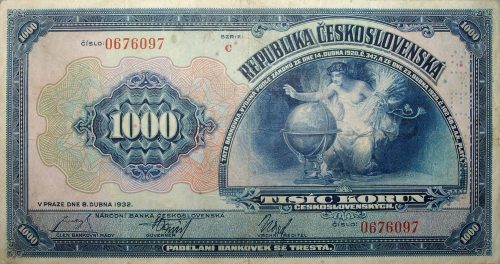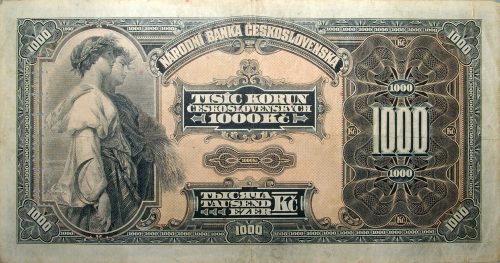P025
Paper, Specimen Fine
198 mm x 103 mm (7-3/4” x 4-1/16”)
HISTORY: Following the end of World War I and the creation of Czechoslovakia as an independent nation in 1918, there was an urgent need to establish a new currency system, distinct from the currencies of other emerging European countries. The following year — on April 10, 1919 — the Czech nation defined the new koruna (Kč) as an equal to the Austro-Hungarian krone. They immediately began printing and circulating currency. Three years later, in 1922, they began minting coins.
Following the fall of the U.S. stock market in 1929, marking the ominous beginning of the Great Depression, the Czech monetary systems succumbed to high inflation, which became a national issue. The koruna was tied to the gold standard at the time but, over heated debate, was abolished in 1931. Minister of Finance Karel Engliš (1880–1961) resigned on April 16 and the National Bank of Czechoslovakia (Národní Banka Československá) fell into turmoil until a slow rebound in 1934.
OBVERSE: This beautifully engraved 1000-korun (“TISÍC KORUN”) “SPECIMEN” banknote was printed by the American Bank Note Company (“© A.B.N. Co”), an obvious attempt to instill a sense of Czechoslovakian prosperity in public perception. Ceres (Roman goddess of agriculture, harvest, and fertility) hovers over a large globe of the earth, arms outstretched, grasping a sheaf of wheat. “© A.B.N. Co” is printed to the right of her left knee. Unknown engraver and designer.
REVERSE: In the composition to the left is Ceres, once again, holding a sickle in her right hand. Her brother Dīs Pater (Roman god of the underworld, who was associated with land and mineral wealth) embraces her shoulder with his right arm while holding a sheaf of wheat in his left. Prosperity was just around the corner.
“© A.B.N. Co” is printed to the lower left of the sickle. Unknown engraver and designer.


